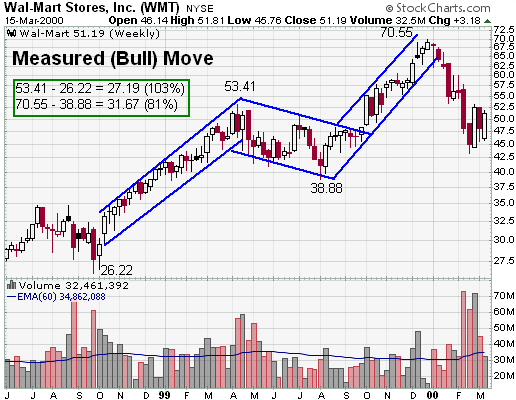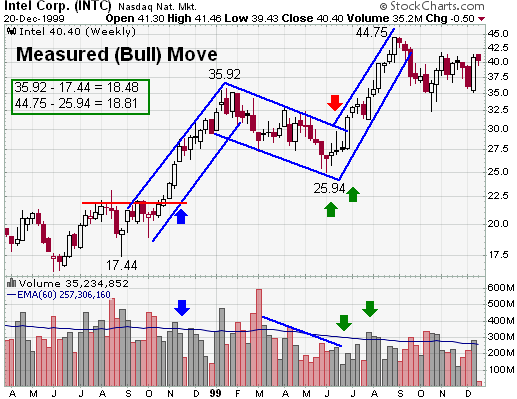|
|
Measured Move - Bullish
The Measured Move is a three-part formation that begins as a reversal pattern and resumes as a continuation pattern. The Bullish Measured Move consists of a reversal advance, a correction/consolidation and a continuation. Because the Bullish Measured Move cannot be properly identified until after the correction/consolidation period, it is categorized as a continuation pattern. The pattern is usually long-term and forms over several months.

- Prior Trend: For the first advance to qualify as a reversal, there must be evidence of a prior downtrend to reverse. Because the Bullish Measured Move can occur as part of a larger advance, the length and severity of the prior decline may vary from a few weeks to many months.
- Reversal Advance: The first advance usually begins near the established lows of the previous decline and extends for a few weeks or many months. Sometimes a reversal pattern can mark the initial trend change. Other times the new uptrend is established by new reaction highs or a break above resistance. Ideally, the advance is fairly orderly and lengthy with a series of rising peaks and troughs that may form a price channel. Less erratic advances are satisfactory, but run the risk of forming a different pattern.
- Consolidation/Correction: After an extended advance, some sort of consolidation or correction can be expected. As a consolidation, there could be a continuation pattern such as a rectangle or ascending triangle. As a correction, there could be 33% to 67% retracement of the previous advance and the possible patterns include a large downward-sloping flag or falling wedge. Generally speaking, the bigger the advance, the bigger the correction. A 100% advance may see a 62% correction and a 50% advance may see only a 33% correction.
- Continuation Advance - Length: The distance from the low to the high of the first advance can be applied to the low of the consolidation/retracement to estimate a projected advance. Some technicians like to measure by points, others in percentage terms. If the first advance was from 30 to 50 (20 points) and the consolidation/correction was to 40, then 60 would be the target of the second advance (50 - 30 = 20 : 40 + 20 = 60). For those who prefer percentages: if the first advance was from 30 to 50 (66%) and the consolidation/correction was to 40, then 66.40 would be the target of the second advance (40 X 66% = 26.40 : 40 + 26.40 = 66.40). The decision of which method to use will depend on the individual security and your analysis style.
- Continuation Advance - Entry: If the consolidation/correction is made up of a continuation pattern, then second leg entry points can be identified using the normal breakout rules. However, if there is no readily identifiable pattern, then some other continuation breakout signal must be sought. In this case, much will depend on your trading style, objectives, risk tolerance and time horizon. One method might be to measure potential retracements (33%, 50%, or 62%) and look for short-term reversal patterns for good reward-to-risk entry points. Another method might be to wait for a break above the reaction high set by the first advance as confirmation of continuation. This method would make for a late entry, but the pattern would be confirmed.
- Volume: Volume should increase at the beginning of the reversal advance, decrease at the end of the consolidation/correction and increase again at the beginning of the continuation advance.
The Bullish Measured Move can be made up of a number of patterns. There could be a double bottom to start the reversal advance, a price channel during the reversal advance, an ascending triangle to mark the consolidation and another price channel to mark the continuation advance. During multi-year bull markets (or bear markets), a series of Bullish Measured Moves can form. While the projections for the continuation advance can be helpful for targets, they should only be used as rough guidelines. Securities can overshoot their targets, but can also fall short – technical assessments should be ongoing.

Intel (INTC) broke out of a multi-year slump and began a Measured (Bull) Move.
- Prior Trend: After a large downward sloping trading range throughout most of 1997 and 1998, Intel broke above resistance in early November (blue arrows) and started the first leg of a Measured (Bull) Move.
- Reversal Advance: The breakout occurred with a strong move above resistance at 22 with 2 weeks of strong volume (green arrows). The advance began from 17.44 and ended at 35.92.
- Consolidation/Correction: After an extended advance, the stock declined within a set range that resembled a large descending flag. The decline retraced about 54% of the previous advance.
- Continuation Advance - Length: The estimated length of the advance was 18.48 points from the June low at 25.94, which would target 44.42. The actual high was 44.75 for an 18.81 advance.
- Continuation Advance - Entry: Because the consolidation/correction portion formed a continuation pattern, entry could have been based on a break above the resistance line (red arrow).
- Volume: Volume increased in early November at the beginning of the reversal advance. There was a decrease from March to May 1999. Volume increased again at the beginning of the continuation advance (green arrows).
